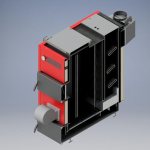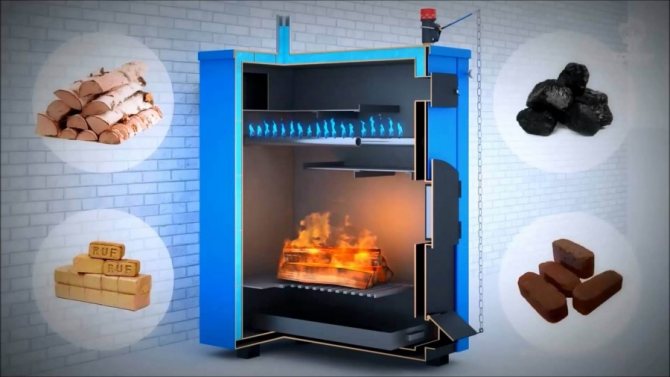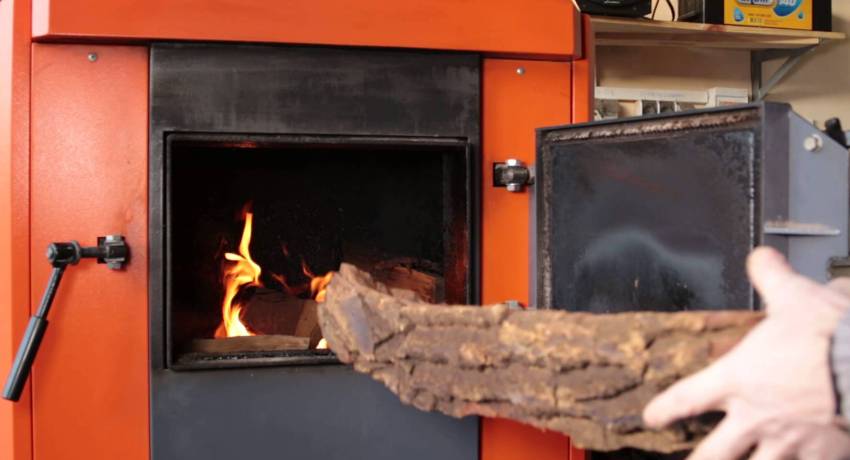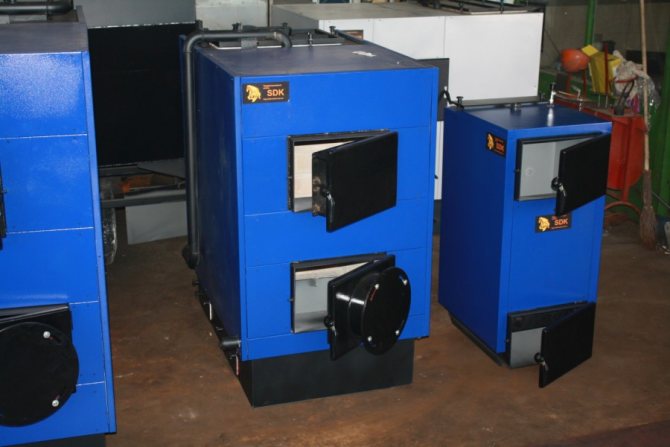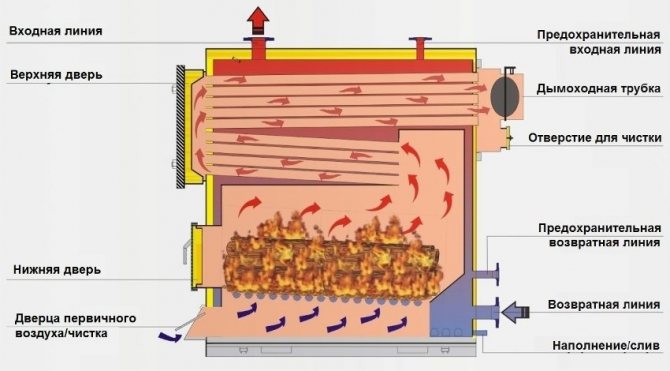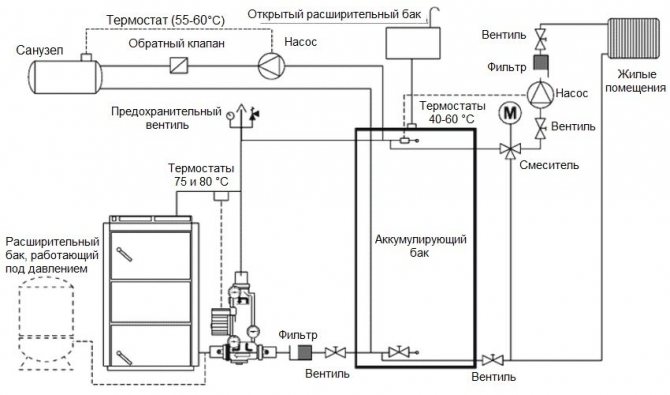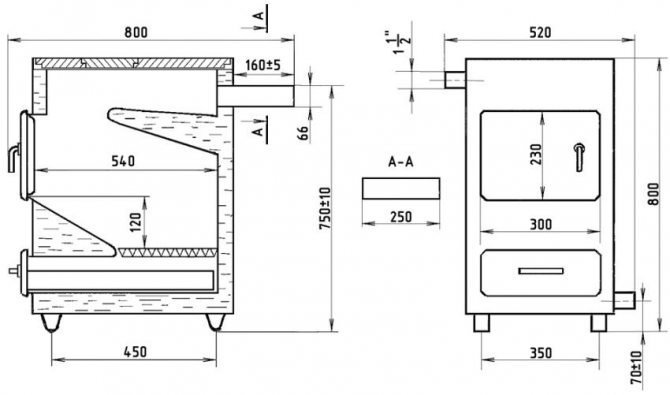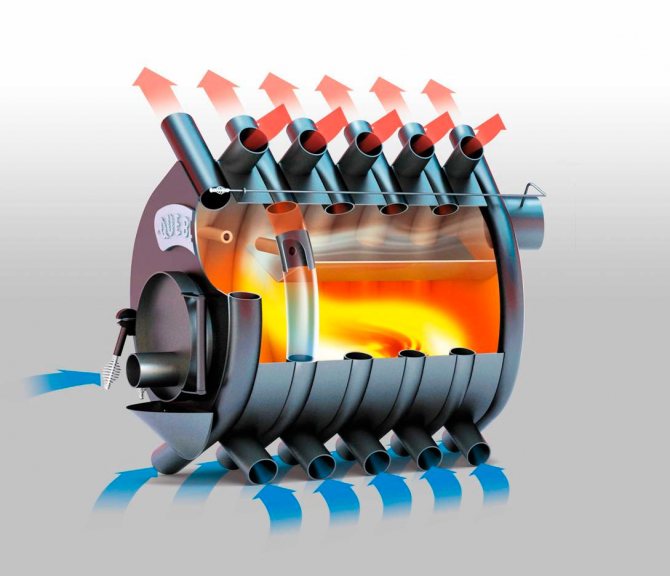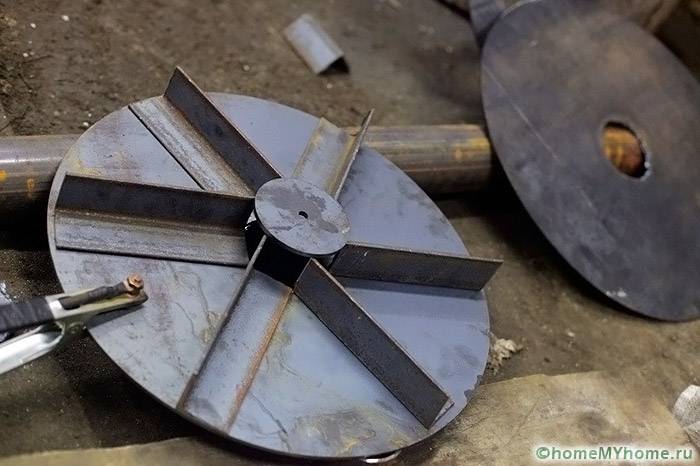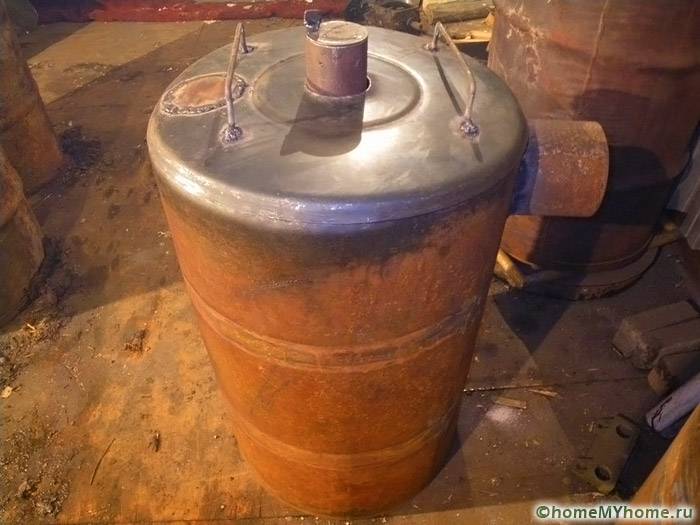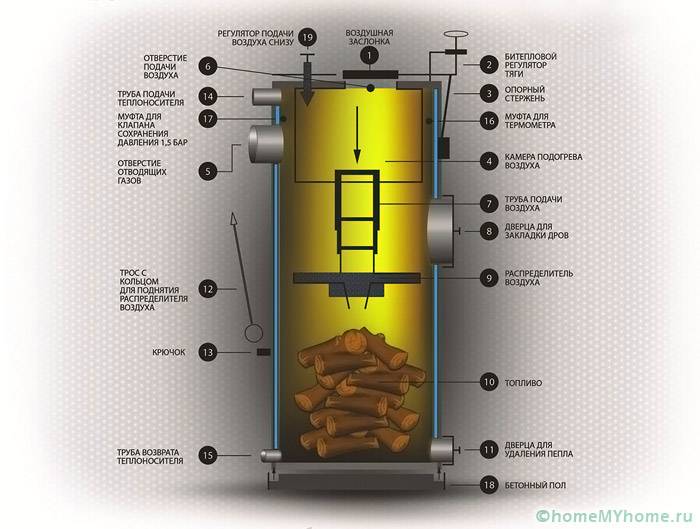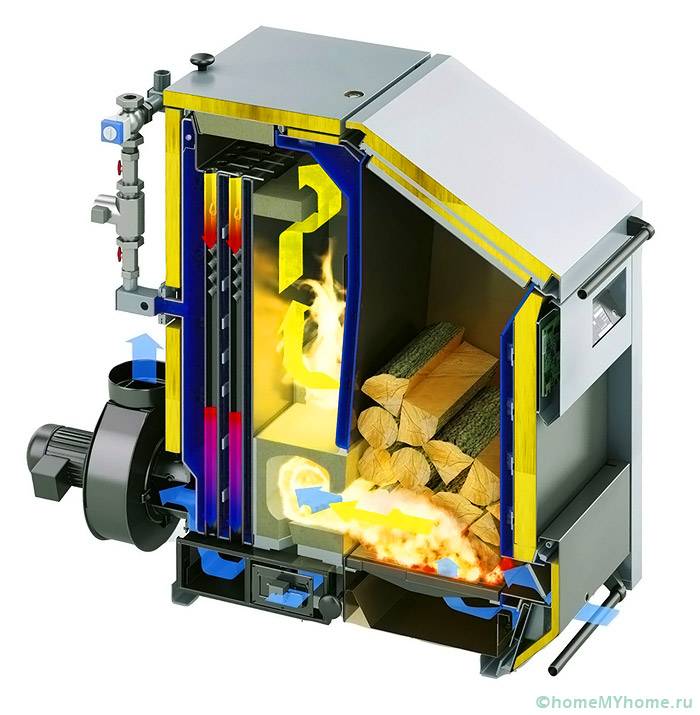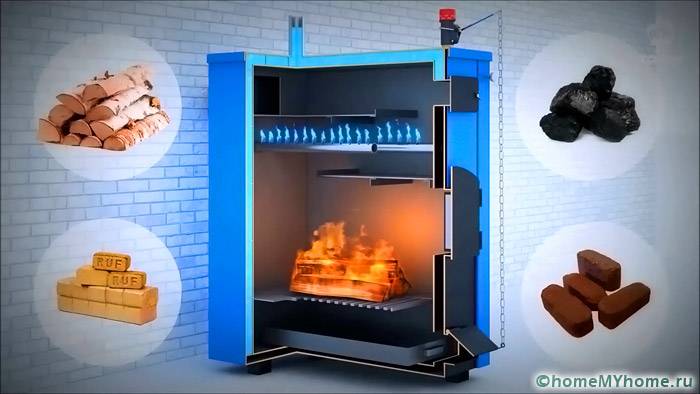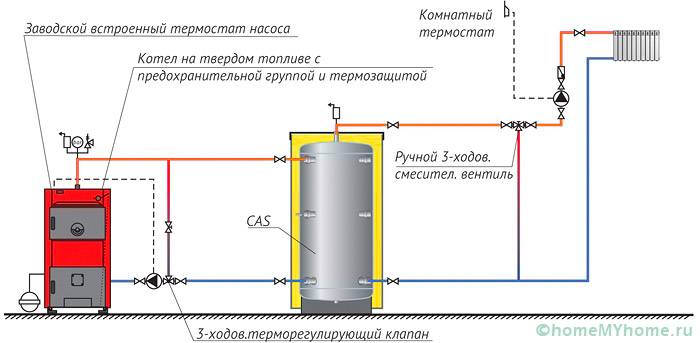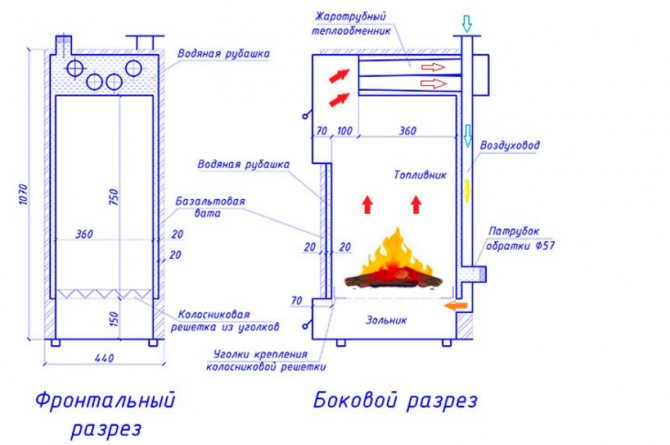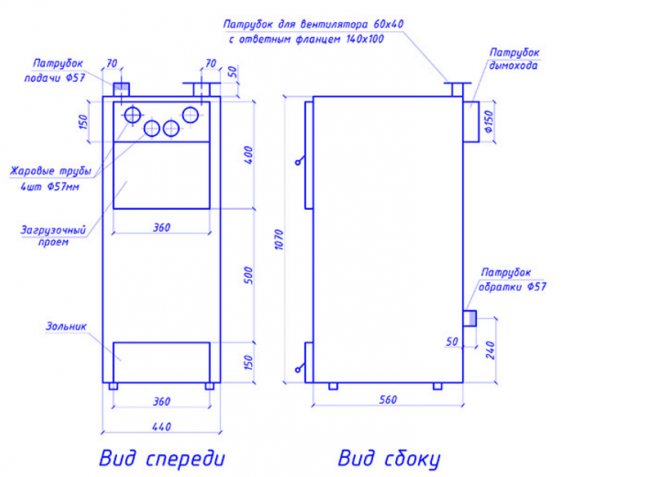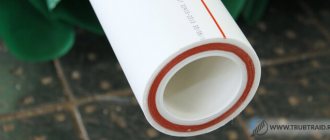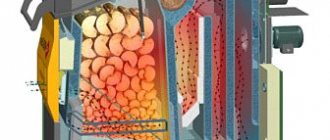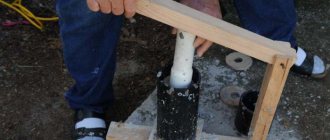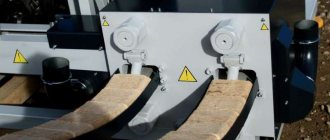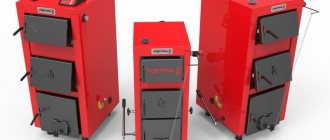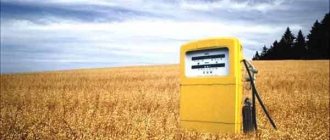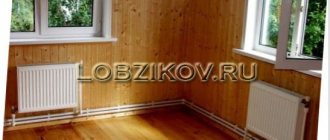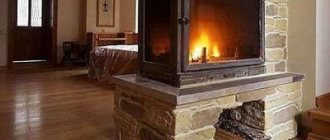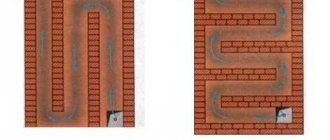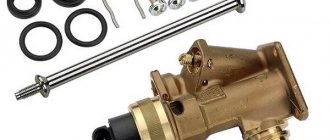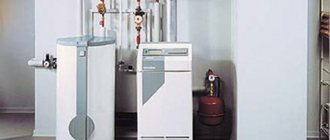Home / Solid fuel boilers
Back to
Published: 10.08.2019
Reading time: 6 minutes
0
2103
Mine boilers (ШК) with long burning pyrolysis type or Kholmov's boilers are one of the varieties of solid fuel heat generators. They belong to the class of non-volatile and efficient units, with forced or natural movement of the gas-air medium.
Usually, mine boilers are manufactured at industrial sites, however, today there are many designs made by craftsmen in compliance with the requirements of norms and standards in the field of manufacturing and safe operation of boiler plants.
Many devices are equipped with energy-efficient functions with an additional water heating circuit and a storage tank.
- 1 Kholmov's cauldron
- 2 How the boiler works
- 3 Advantages and disadvantages
- 4 Manufacturing a mine pyrolysis boiler 4.1 Diy boiler creation algorithm.
Kholmov's boiler
This modification of the furnace differs in that it is equipped with two chambers - for installing a heat exchanger and separately for burning fuel. These devices with bottom combustion and full height of the furnace, which became the name for them. The principle of operation depends on the design.
The most popular today are two designs:
- Kholmov pyrolysis boilers (PC);
- normal combustion.
The fuel burns at the bottom of the closed combustion chamber. The second shaft is smaller, serves for afterburning flue gases and cooling them in the boiler for heating water for heating.
Non-volatile devices control the temperature with an RT3 thermostat installed at the front of the structure. For completeness of fuel combustion, the air supply to it is regulated by the blowing door located on the main door of the ash pan.
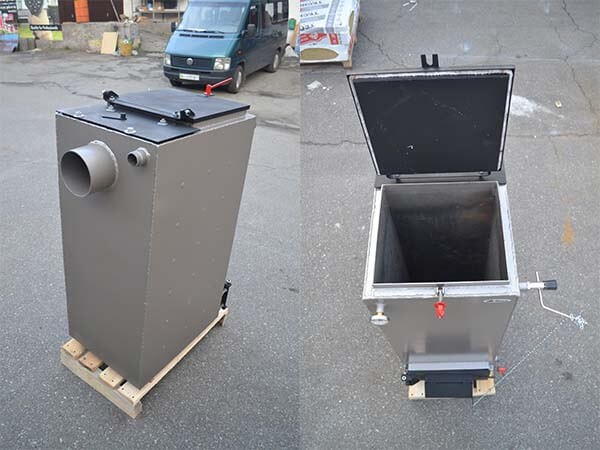
Kholmov's boiler. Top and side view
A special restriction shutter is installed to ensure the minimum air passage. In the upper rear part of the unit there is a branch pipe for connecting a chimney that provides natural draft.
The boiler is equipped with a shut-off valve and compensators on the outside and inside the casing, designed to prevent weld seams from bursting during emergency overheating.
Boiler working principle
The heat generation process takes place in two ways: direct combustion of natural fuel and afterburning of a pyrolysis gas mixture formed due to lack of air. Some of the fuel smolders, giving off tar and soot smoke. Further, the gases migrate through the coals, saturated with combustible components, and turn into a gas-combustible mixture.
These units are of the mine type - with bottom combustion. The process is carried out at the level of 20.0 cm in the lower zone of the furnace space. The upper fuel waits in hot reserve while the lower one burns out. Flue gases collect about 30.0 cm above the fuel.
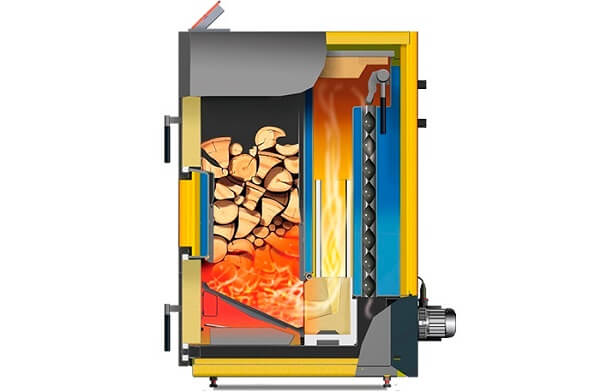

The main volume of primary air falls under the grate and moves to the part of the pyrolysis afterburner. It captures flue gases above the combustion level.
The mines are separated by a partition having a small gap at the bottom, through which the flame is drawn by thrust from the first chamber to the other, where the complete afterburning of combustible gases is completed, washing the convection heat exchanger from T +850 C.
The heating circuit in the water jacket of the shaft-type boiler is subjected to radiation heating, the residual heat is transferred to the convection-type heat exchanger.
We make a boiler with top combustion of fuel
In fact, a huge number of instructions for the manufacture of such heating units have already been published on the Internet, since for some reason they are considered to be long-burning boilers. True, none of them tells how a home craftsman can make a round body and a water jacket without a rolling machine. The rectangular shape of the firebox will not work - in the corners the wood will burn worse and "hang" on the walls.
Note. The old propane gas cylinder used to make Bubafoni is not suitable for the boiler - the volume is too small (only 50 liters). With such a chamber, you will not get an ultra-long burning heat generator. You need a steel pipe with a wall thickness of 4 mm and an outer diameter of at least 40 cm.
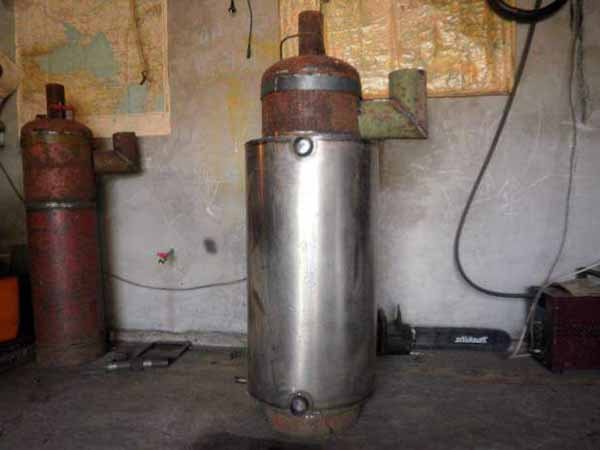

The simplest solution is to dock 2 gas cylinders and make a primitive shirt
More of the materials you will need:
- sheet metal for a water jacket 3 mm thick;
- Ø57 mm pipe for air duct and Ø100 mm for flue gas outlet;
- sheet 1 cm thick for a round "pancake";
- fittings or corners for assembling the grate;
- strip 40 x 4 for air distributors.
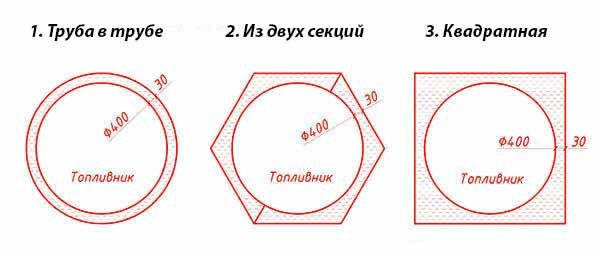

How can you put a shirt on a cylindrical firebox
For insulation of the case, take the same high-density basalt wool and painted metal for the cladding. It remains to solve the main question - how to bend metal under a cylindrical firebox at home in order to make a water jacket. Options for a way out of the situation are reflected in the diagram - if there are no rollers nearby, the sheathing is made of segments in the form of a polyhedron or just a square section.
Advice. Perhaps you will be able to find a pipe of a larger diameter and put it on the firebox, but then the weight of the heater will be quite impressive, and it will take a long time to warm up.
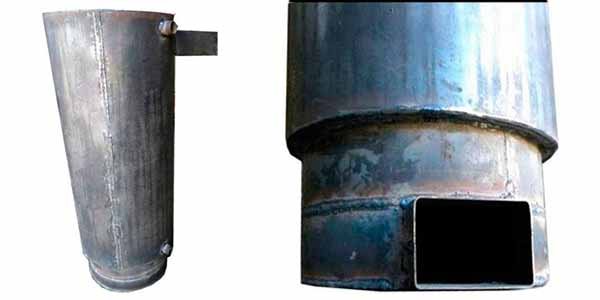

The assembly of a TT-boiler for continuous upper combustion is carried out as follows:
- Weld the shelves for the grate inside the main pipe and place the bottom. Make cutouts for the doors and chimney. Make a grate and put it in place.
- Make a "pancake" according to the drawing with a hole in the middle, where insert and scald the air pipe. Cut out the top cover of the unit with an opening for the pipe, and then place the weight inside the firebox. Put on the cover and secure it with welding.
- Cover the water jacket and weld it in the same way as described in the previous section. Assemble the doors using the same technology.
- Install all branch pipes, insulate and clad the boiler.
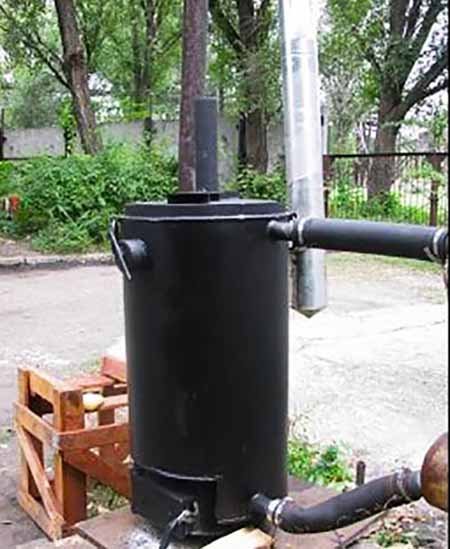

This completes the assembly process. To make the unit look attractive, paint all unstitched elements black or another dark color and proceed to testing.
Advantages and disadvantages
The mine unit has the following main advantages:
- Versatility, availability of work on different types of fuel, including liquid for modified installations.
- High boiler efficiency, productivity and autonomy without additional fuel loading up to 24 hours.
- Clever design for easy maintenance, loading / unloading is done through separate hatches.
- Reliability and safety, therefore, gas contamination of the premises and carbon monoxide poisoning, one might say, are reduced to "zero".
The disadvantages include:
- increased soot formation and tar formation during fuel combustion;
- huge dimensions of the installation.
Do-it-yourself solid fuel boiler for long burning: video instructions and conclusions
For the manufacture of some complex structures, you will need to pre-equip your own workshop. We'll have to master working with welding equipment, purchase specialized tools and accessories.If it is not useful in the future, then the corresponding costs will have to be taken into account when calculating the total cost.
The materials of this article, information from the drawings and video will help to create the correct long-burning boiler with your own hands. But for a correct assessment, it is necessary to check how much it will cost to complete the corresponding order with the help of professionals.
Production of a mine pyrolysis boiler
Modified PCs are in great demand today, with high efficiency, allowing you to save a significant amount of fuel and functioning from one filling for more than a day. The simplicity of the design makes it possible to manufacture a boiler with even a little experience in welding.
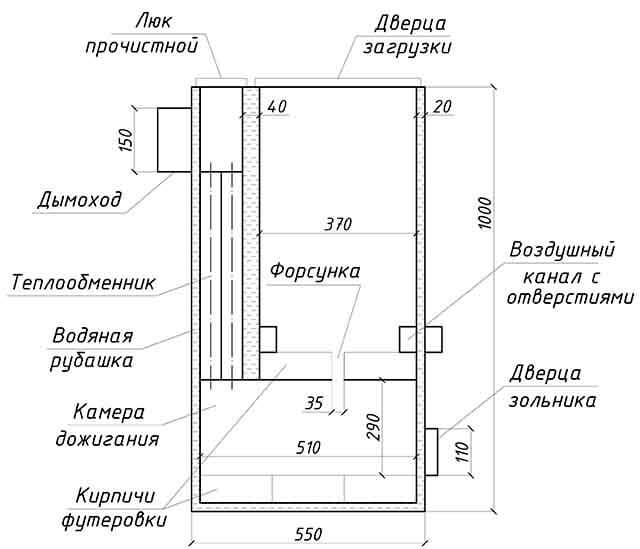

Drawing of an ordinary pyrolysis boiler
The basis for creating an effective Kholmov boiler with your own hands will be reliable design documentation: drawings, specifications and calculations, which can be found on the Internet today.
When choosing the desired drawing of the unit, they pay attention to the volume of loading of the device, the larger it is, the longer the work will be and what the power of the heat generator depends on.
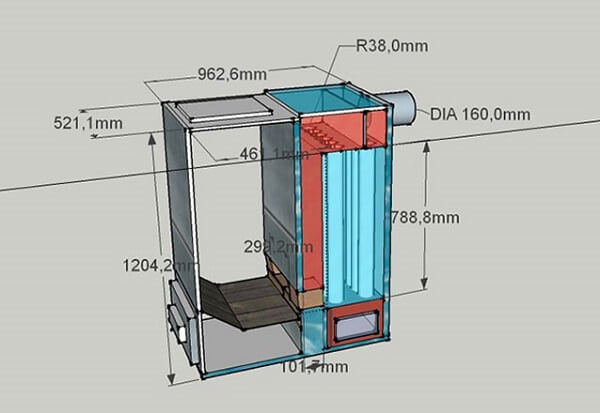

Algorithm for creating a boiler with your own hands.
- They carry out the main part of the device and divide it into two chambers, installing partitions and valves for air supply.
- A diagram of parts is transferred to a metal sheet and cut out by autogenous.
- Side elements are welded with a reinforced seam.
- 2 holes are cut between the boiler and the firebox in the partition - at the top and bottom near the grate.
- Install the details of the firebox and scald them.
- Attach the latch at the upper hole and secure it.
- The grates are made with cutting of narrow longitudinal slots.
- The grates are placed on metal corners (cast iron) or welded (steel).
- Doors of the firebox and ash pan are made.
- A boiler is installed and welded from pipes of 25 mm with a water jacket.
- Equip the afterburner chamber of the smoke-gas mixture by welding a partition next to the grate.
- A hole is made at the bottom for installing a 50 mm air pipe with a blind damper at the outlet end and many holes to create a uniform air flow.
- The combustion chamber is insulated with chamotte, and then it is additionally insulated with basalt wool, which increases the thermal efficiency of the boiler unit.
- Further, the installation of the manufactured equipment, the piping of the water and smoke and gas paths, the installation of heating, and then the pressure testing of the system are carried out.
Making a classic model
The construction of a reliable TT-boiler that can last more than 15 years requires the use of the following materials:
- low-carbon sheet steel grade St10—20 4 mm thick for the manufacture of a firebox;
- the same, 3 mm thick - on the water jacket and doors;
- metal strip with a section of 20 x 3 or 20 x 4 mm;
- a piece of pipe with a diameter of 150 mm to the chimney;
- pipe Ø57 mm with a wall thickness of at least 3.5 mm for the heat exchanger;
- profile pipe 6 x 4 cm for the air duct;
- corner with a shelf width of 5 cm made of thick metal (4-5 mm) on the grate;
- powder coated sheet steel for exterior cladding.
Advice. Do not use high-carbon steel above St20 on the firebox. Firstly, it is more expensive in price, and secondly, it overheats from welding and can crack at the joints. It is better to buy ready-made handles for doors with ebonite linings, they hold tighter and look more beautiful.
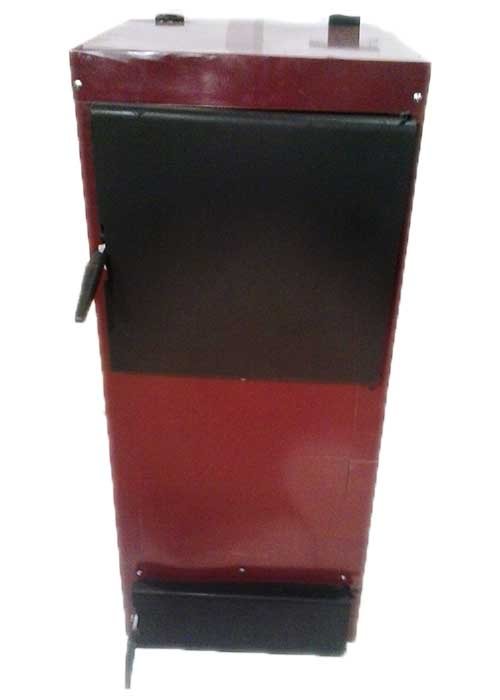

Of the additional materials, you will need basalt fiber with a density of 80-100 kg / m³ for thermal insulation of the body and an asbestos-graphite cord for sealing the doors. The automation kit and fan mentioned in the previous section are made in Poland, model KG Elektronik SP-05. There are also Chinese counterparts on the market, they are cheaper.
Step one - welding the body
To weld the fuel chamber, it is necessary to cut 4 mm metal into blanks according to the dimensions indicated in the drawing.Start collecting from the bottom of the ash pan - grab the side walls and the lid to it, and then form the frames for the loading and cleaning door, as shown in the photo.


Then follow this algorithm:
- Weld the grate supports inside the firebox, and steel strip clips for mounting the water jacket outside.
- Install and weld the 3mm outer sheathing sheets of the water jacket. Note that it originates from the top of the ash chamber.
- In the upper compartment, which will subsequently be filled with a coolant, cut 4 flame pipes Ø50 mm, put the same pipes on the connection to the heating system.
- Attach the legs from the pieces of any rolled metal to the unit and mount the chimney at the outlet of the fire-tube heat exchanger.
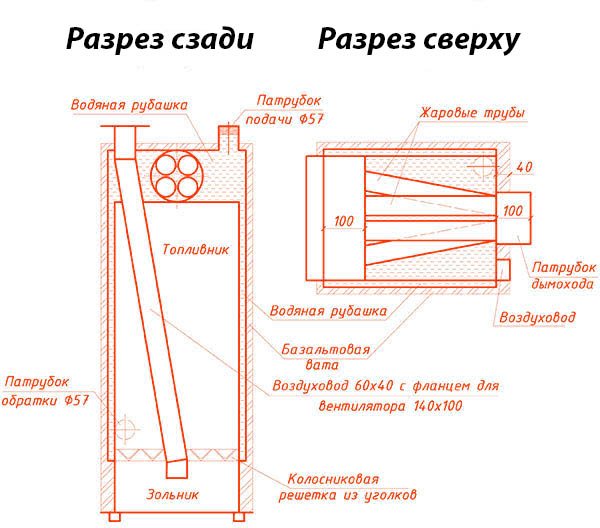

Note that the flame tubes converge in a bundle to the chimney
Advice. If you are planning to make a long-burning double-circuit boiler, then a water coil for hot water supply is installed at this stage. The best place for a copper or stainless steel heat exchanger is inside the upper boiler tank, next to the flame tubes.
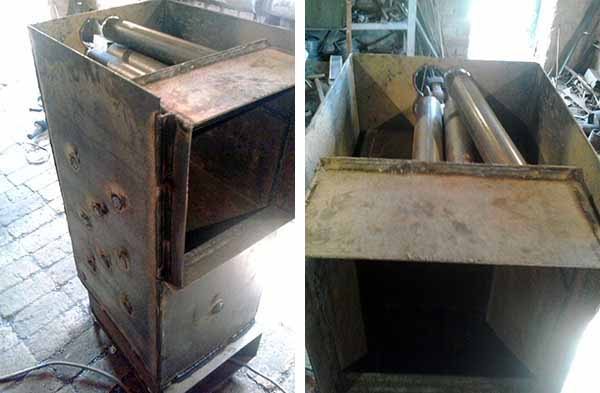

Stage two - installation of hinged elements
The doors of the fuel and ash chamber are made by bending the edges of the blanks and welding the inner frame, where the basalt insulation is placed. From above, the insulation is hermetically closed with a lid, and an asbestos-graphite cord is tightly inserted into the resulting groove along the perimeter of the sash.
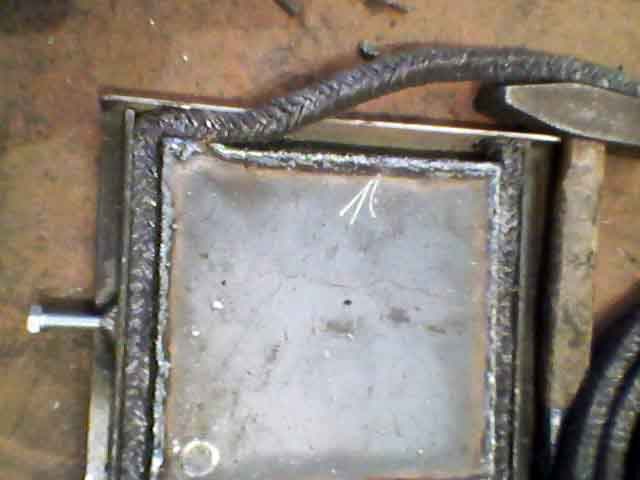

What else needs to be done:
- Attach the handles and hinges to the body and cover the doors with heat-resistant enamel.
- Weld a grate from the corners and put it in place.
- Make an air duct with a counter flange and weld it to the back wall, as shown in the photo.
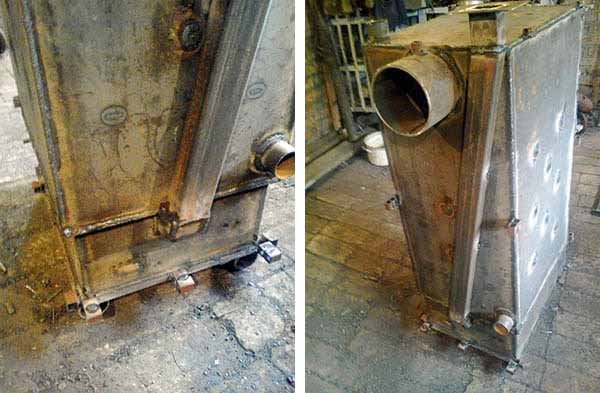

To insulate and coat a homemade TT boiler, it is necessary to weld embedded parts of any metal at the corners of the water jacket, so long as its width does not exceed 20 mm (on the back wall - 4 cm). Also provide stands for attaching the ECU to the top of the unit.
Final heater assembly
Thermal insulation of the boiler tank is simple - the walls are lined on the outside with slabs of basalt wool, which are fixed with a cord. Make sure that the insulation fits tightly to the frame of the loading and ash opening, as well as to the profile pipe of the air duct.
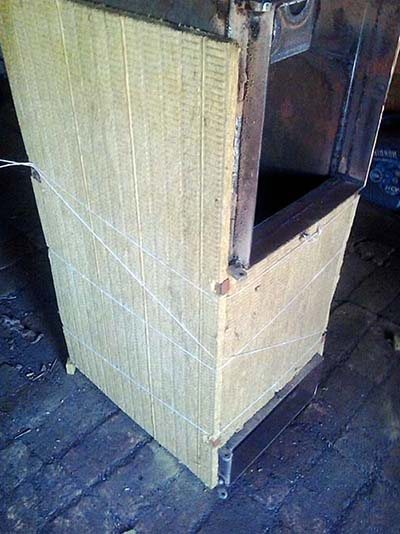

Advice. Before insulation and cladding, it is required to mount a temperature sensor from the automation unit into the case. The standard solution is to install an immersion sleeve, but you can do it easier - put it between the insulation and the wall of the jacket in the hottest place - in the area of the firebox arch.
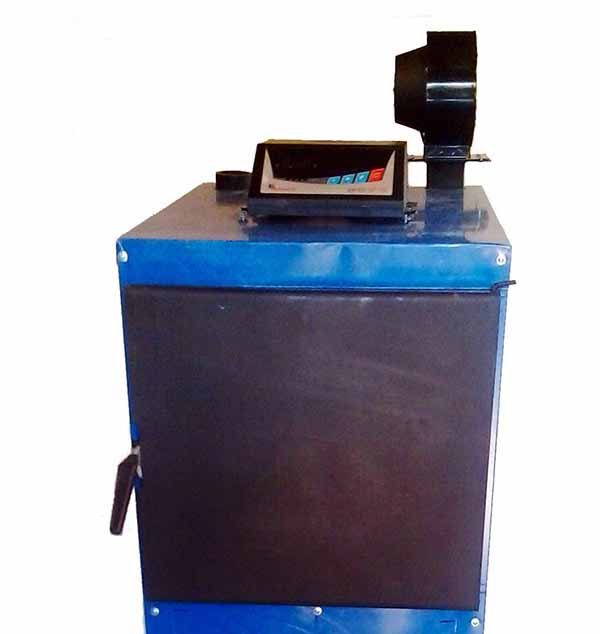

This is how the control unit and the fan are mounted.
The last step is to cover the heat generator with polymer-painted metal, which is screwed to the previously welded embedded parts with self-tapping screws. After that, the doors are hung and an automation unit with a fan is installed. The author's video from the developer of this long-burning TT-boiler Vitaly Dashko will help you to understand the assembly process:
Best Mine Boilers
Pyrolysis type SCs are in demand today among the population living in one-story and two-story houses, since they have proven their effectiveness and demonstrated ease of use.


The market quickly reacted to the requests of buyers and was filled with a wide variety of units of domestic and foreign manufacturers.
In the online shopping ratings in 2020, the greatest demand is for units with a service life of more than 20 years and innovative heating surfaces.
Main characteristics of mine boilers.
| Indicators | Pyrolysis 43 Kp-10 | Heiztechnik (12 kW | Wirbel ECO CK Plus 25 |
| Price | RUB 67100 | RUB 215760 | RUB 277 845 |
| Model | 66694 | 90128 | 80023 |
| Manufacturer | Pyrolysis 43 | Heiztechnik | Wirbel |
| Short description | Duration of work on 1 tab is up to 10 hours.Efficiency 85% to 90%. Energy intensity, Low fuel consumption Automatic maintenance of heating temperature. | Power 12 kW, new EU, innovative technology. Environmentally friendly heating installation with an improved self-igniter burner and a self-cleaning system. Efficiency - 91%, heating temperature - 85 C. | Universal unit for liquid and solid fuels. The range of the heated medium is 40/90 C, the efficiency for solid fuel is 85%, for liquid fuel - 90% |
| Power, kWt: | 10 | 12 | 25 |
| Weight, kg | 210 | 350 | 271 |
| Dimensions (HxWxD), mm | 1070x500x800 | 1370x1150x550 | 1260x915x1070 |
| Chimney diameter, mm | 160 | 150 | 160 |
| Producing country | Russia | Poland | Germany |
Thus, summing up the line, it can be argued that shaft-type boilers are efficient devices with low specific fuel consumption. Such units are today used for individual heating of residential and public, significantly reducing the heating costs of owners.

